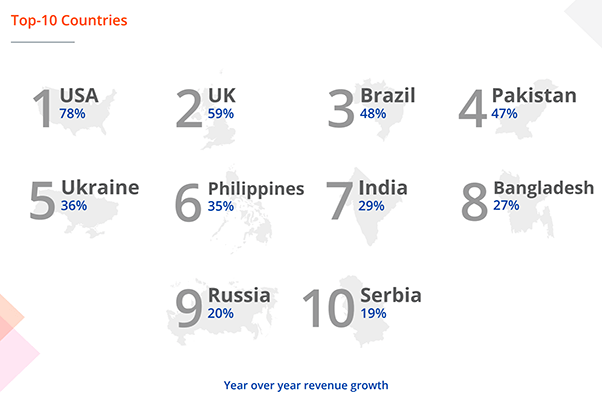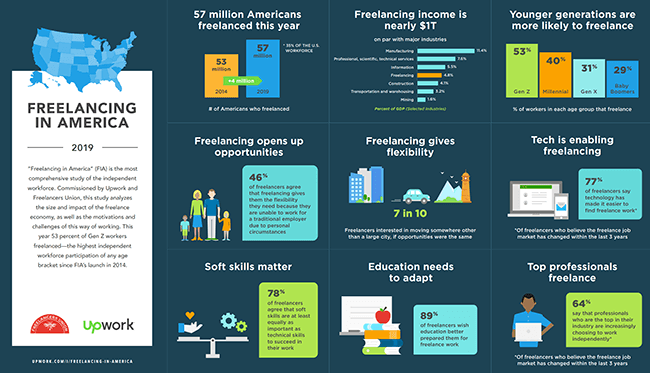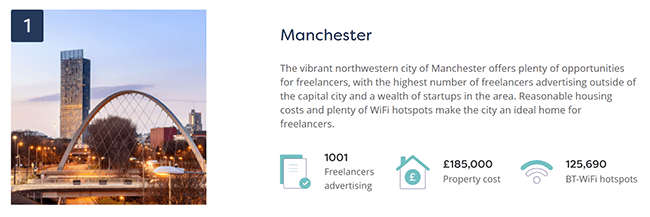50+ Freelance Statistics For 2024: Stats, Facts & Trends
These days, it seems like everyone wants a side hustle. And who can blame them? Freelance work affords people the opportunity to be their own boss, set their own hours, and make as little (or as much!) money as they want to.
Escaping the corporate 9-5 is something most people think about at some point or another. In fact, the thought of earning an extra bit of side cash, or even transitioning to full time freelance work, is an appealing concept that spans the world.

And since earnings continue to rise across the world, no matter the industry, it’s easy to see why more people than ever are jumping in and giving freelancing a shot.
But is giving up your stable office job worth it?
If you’re on the fence about whether to break into the world of freelancing, check out these top freelance statistics you need to know. You’ll soon realize that freelancing has become an increasingly popular and highly viable way to make a living, no matter where in the world you are.
Editor’s picks
- 28.5 million freelancers found in the U.S. say they purposefully made freelance work their long-term career choice. (Upwork)
- 52.2% of freelancers have a master’s degree or a PhD. (EFIP and Malt)
- 31% of freelancers make more than $75,000USD per year. (SkillScouter)
United States – freelance statistics
Freelancing in America offers people a flexibility not found in many other professions. This is probably why Upwork’s freelancing study, called “Freelancing in America – 2019,” found that 71% of freelancers agree that freelancing provides them a way to:
- Work from anywhere they want
- Earn the extra income they need
- Escape working for a traditional employer
Key findings in this study include:
More Americans than ever are freelancing: in 2019, more than 57 million Americans (up from 53 million in 2014) admitted to freelancing. This represents 35% of the U.S. workforce. Adding to that, full-time freelance work has increased in America. As of 2019, 28% of freelancers in the United States are full-time freelancers, meaning they make the rules when it comes to their jobs.
Americans choose to freelance: though sometimes people jump into freelance work because they fall on tough times, the truth is, 60% of American freelancers claim they chose to become freelancers. Better yet, the 28.5 million freelancers found in the U.S. say they purposefully made freelance work their long-term career choice.
Skilled services is the top freelancing job: when it comes to freelancing, there is a lot of choice. However, the most common type of freelance work in the states deals with skilled services. Providing skills like programming, marketing, and consulting, the bulk of American freelancers are in it to help others succeed too.
Younger generations are more drawn to freelancing: Gen Z (those born after 1996) are most likely to take up freelancing when compared to other generations. In fact, 53% of workers aged 18-22 performed some freelance work in 2019, making this the highest rate of participation of any generation since 2014.

As the most comprehensive study of the independent workforce, “Freelancing in America” (FIA) has determined that in the future, freelance work in America will not end:
- 51% of freelancers state that no amount of guaranteed money could convince them to switch back to a traditional job
- 71% say that freelance work is gaining a more positive perception as a career option
- 91% believe that better days are ahead for freelancers
- 59% of non-freelancers say they’ll likely do freelance work at some point in the future
That said, freelancing in America doesn’t come without its challenges. According to Upwork, freelancers worry about things like:
- Affordable healthcare
- Making enough money
- Retirement funds
- Being paid fairly
- School loan debt
European – freelance statistics
Much like the United States, Europe has experienced a significant shift in the workplace. With more freelancers than ever making up the European workforce, the European Commission has made clear the European SME Definition should “acknowledge freelancers as a stand-alone category within the definition and legitimise the smallest of small businesses, those who – with a 45% increase since 2000 are the fastest growing segment of the EU labour market.”
According to a survey performed by EFIP and Malt, compiled in what is called “Freelancing in Europe,” European freelance workers find themselves working in multiple fields. However, the most common include:
- 30.9% are in marketing and communication
- 26.5% are in the IT/tech industries
- 18% are in the arts, entertainment, and recreation categories
There are about the same number of women freelancers in Europe as there are men, though more women than ever are finding balancing freelance work, family obligations, and working in other non-freelancing professions easier than ever.

In addition, unlike in the United States, the majority of European freelancers are aged 35 and over, which is a far cry from the Gen Z generation.
Many freelancers pride themselves in having a solid education. Valuing lifelong education over most things, 52.2% of freelancers have a master’s degree or a PhD, despite degrees mattering less than in the past when it comes to freelancing.
Lastly, it’s important to emphasize that freelancers in European decide to get into freelance work for a myriad of reasons:
- 46.8% enjoy having flexible schedules
- 37.4% want to be able to choose their own projects
- 36.9% love being able to work from any location
- 35.6% desire to be their own boss
In keeping with the American freelancers, many European freelancers would forgo a salaried position even if they were offered one.
Challenges facing European freelance workers include:
- Being paid fair wages and/or income fluctuations
- Not having automatic unemployment insurance
- Finding enough work (especially in the beginning)
- Lack of familial and friend support for their career choice
- Working more hours than traditional salaried workers
- Having to work multiple freelance jobs to earn enough
- Difficulties paying freelance taxes and setting up a business
- Pressure to continuously find ways to be more productive
UK – freelance statistics
The UK has become increasingly dependent on the freelance workforce across many industries. In fact, some would go so far as to say that freelance work in the UK is the backbone of the economy and that without it, the British would suffer on many levels.
Within the last year, Simply Business revealed some of the best freelance statistics you need to know about UK freelancers starting with the fact that:
Freelance work has significantly increased in specific industries: from 2018 to 2019, there was a whopping 31% increase in people looking to get into freelance work. That said, the top freelance positions included dog walkers (60% increase), beauticians (159%), hairdressers (51%), photographers (91%), and bakers (68%).
London is not favorable for freelance workers: London is still known for traditional professions such as accountant, teacher/tutor, project manager, caterer, and graphic designer, even if performed by freelancers. On the other hand, the Midlands, East Anglia, and North East England are filled with freelance hairdressers (including mobile), teachers/tutors, dog walkers, and couriers.
The Office for National Statistics shows an increase in freelance workers: from 2001 to 2017, self-employed workers increased from 3.3 million to 4.8 million. Contributing over £275 billion (nearly $360 billion USD) to the UK economy, it’s easy to see how freelancers help hold things together.
Money Super Market has this to say about UK freelancers:
- The most popular freelance careers in all of the UK include: business support (22%), design (20%), and writing and translation (17%)
- The number one location to freelance is Manchester thanks to low property costs and plenty of WiFi hotspots (Brighton & Hove, Edinburgh, and Belfast are right behind in popularity)
- Freelancers average 27 hours of work per week, which is far less than the whole of Europe
- 61% of freelancers are happy with their career choice
- Those in freelance hated commuting, the stress, and not being the boss at their traditional corporate jobs

The study goes on to say that UK freelancers love the flexibility that comes with working on projects hand-picked by none other than yourself, the flexible working hours, and of course, something we see over and over – being the boss.
That said, UK freelancers do not like the inconsistent cash flow, lack of company pension, and being responsible for finding work all the time.
Bidivine compiles an impressive set of UK freelancing trends that start by claiming that as of 2018, there were over 3 million sole proprietorships in the UK. That accounts for nearly 15% of the entire labor force.
When it comes to UK freelance ages, this is the breakdown:
- 3.1% are aged 18-24
- 8.5% are 25-34
- 13.4% are 35-49
- 13.7% are 50-64
- 4.0% are over 65
Adding to that, 1 in 7 UK freelancers is a mother. This just adds to the fact that freelancing appeals to a variety of people, all living different lifestyles. Flexibility when it comes to clients, hours, and location are trends we see no matter where in the world the freelancers are.
Japan – freelance statistics
Japan has long been known for having some of the most loyal, hardworking employees around. But as times change, so do professions. And while the appeal of freelancing is spreading like wildfire across the globe, it’s good to know Japan is not immune.
Though Japan is slower to accept freelance work as a viable career choice, things are slowly starting to change. That said, freelance work in Japan is still not highly respected when compared to company employees that clock in and out everyday.
According to the Cabinet Office, 3.4 million people work as freelancers in Japan, which is a mere 5% of the 66 million workers plodding ahead each day. In addition, approximately 1-1.6 million of those freelance workers only do it on the side to earn some extra cash.
Here are some other notable freelance statistics you should know about Japan:
- Depending on the exact definition of freelancing, there may be as many as 10 million freelancers in Japan
- 2.7% of the nation’s workforce claim to freelance full-time, which pales in comparison to the United States’ 6.9%
- Roughly 1.7 million freelancers are paid by corporate companies for the services they provide
- About 20% of people that freelance as their main source of income are in the construction industry
Problems that freelance workers in Japan face include:
Not being respected: many still feel that freelancers are not qualified or competent to do the job at hand and are far less professional than corporate employees. In other words, you have zero credibility.
Banking hurdles: much like other places in the world, the banks in Japan are hesitant to loan money to freelancers for fear they default on their financial obligations.
Difficulty in the traditional workforce: past freelancers seeking a job in the corporate world find that the label ‘freelancer’ hinders their chances of being hired, especially in competitive industries.
In addition, daycare services give priority to corporate workers, fair compensation is an issue, and high-quality healthcare is nearly impossible as a freelance worker in Japan.
Bonus statistics on freelancing
In addition to understanding freelancers in different parts of the world, here are some compelling freelance statistics you need to know before you decide not to join in:
- Working from home can increase performance by as much as 13%
- Most wanted freelance skills include Instagram marketing, brand strategy, and AI development
- The average global hourly rate is $19/hour
- 31% of freelancers make more than $75,000USD per year
- 84% of freelancers claim that with freelancing they can live the lifestyle they want
- 67% of freelancer polled state that freelance pay should continue to rise
- 48% say that freelancing is a work style meant to last long-term
Wrapping up
And there you have it! Freelance statistics you need to know that can help you decide whether freelancing is the best route for you to take, whether as a side hustle or long-term.
Of course, freelance work isn’t for everyone. And much like all other jobs, freelancing comes with its fair share of challenges. That said, sometimes the pros outweigh the cons. When it comes to work/life balance, freelancing often offers the best way to make enough money to be comfortable without having to work too much.
So, if you’re looking for a specific lifestyle that supports the ultimate in job flexibility, freelancing – no matter where in the world you live – might just be the perfect solution.
Related Reading:
